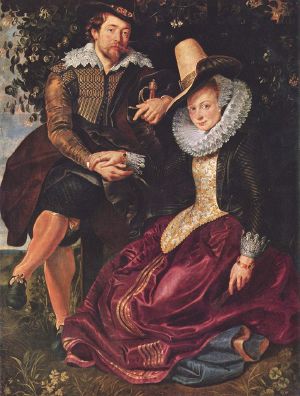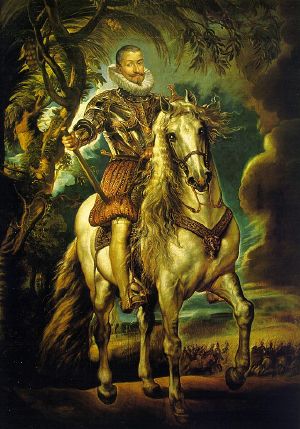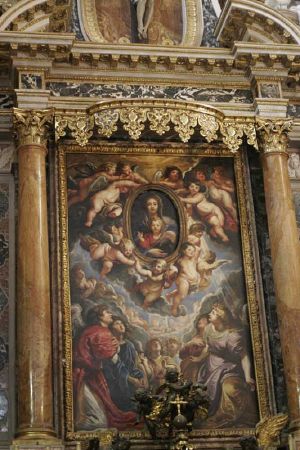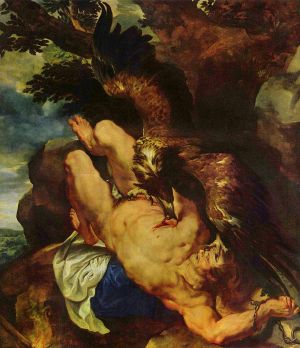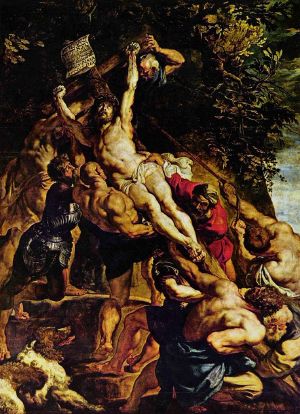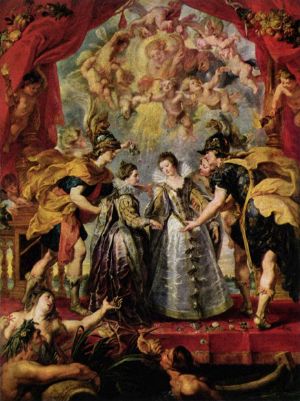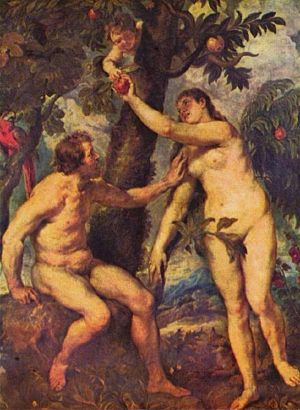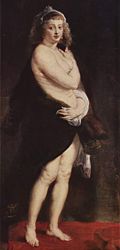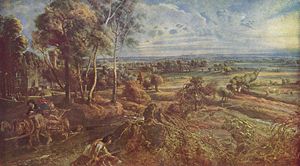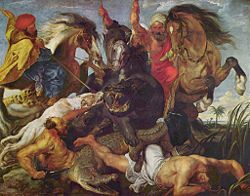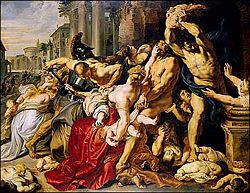Rubens, Peter Paul
m (Robot: Category fix) |
|||
| Line 21: | Line 21: | ||
}} | }} | ||
| − | '''Peter Paul Rubens''' ([[June 28]], [[1577]] – [[May 30]], [[1640]]) was a prolific [[17th century|seventeenth-century]] [[Flemings|Flemish]] | + | '''Peter Paul Rubens''' ([[June 28]], [[1577]] – [[May 30]], [[1640]]) was a prolific [[17th century|seventeenth-century]] [[Flemings|Flemish]]painter who is often said to be the greatest of the Northern [[Baroque]] artists. This exuberant style emphasized movement, color, sensuality and emotional drama. He is well-known for his [[Counter-Reformation]] [[Altarpiece|altarpieces]], [[Portraiture|portraits]], [[Landscape painting|landscapes]], and [[History painting|history paintings]] of mythological and allegorical subjects. In addition to running a large studio in [[Antwerp]] that produced paintings popular with nobility and art collectors throughout Europe, Rubens was a classically-educated [[Humanism|humanist scholar]], art collector, and diplomat who was [[Knight|knighted]] by both [[Philip IV of Spain|Philip IV]], king of Spain, and [[Charles I of England|Charles I]], king of England. |
==Biography== | ==Biography== | ||
[[Image:Peter Paul Rubens 105.jpg|thumb|left|"Rubens and [[Isabella Brant]] in the [[Honeysuckle Bower]]", 1609-10. [[Alte Pinakothek]], Munich.]] | [[Image:Peter Paul Rubens 105.jpg|thumb|left|"Rubens and [[Isabella Brant]] in the [[Honeysuckle Bower]]", 1609-10. [[Alte Pinakothek]], Munich.]] | ||
===Early life=== | ===Early life=== | ||
| − | Rubens was born in [[Siegen]], [[Westphalia]], to Jan Rubens and Maria Pypelincks. His father, a [[Calvinism|Calvinist]], and mother fled Antwerp for [[Cologne]] in 1568, after increased religious turmoil and persecution of [[Protestant|Protestants]] during the rule of the [[Spanish Netherlands]] by [[Fernando Álvarez de Toledo, 3rd Duke of Alba|the Duke of Alba]]. Jan Rubens became the legal advisor | + | Rubens was born in [[Siegen]], [[Westphalia]], to Jan Rubens and Maria Pypelincks. His father, a [[Calvinism|Calvinist]], and mother fled Antwerp for [[Cologne]] in 1568, after increased religious turmoil and persecution of [[Protestant|Protestants]] during the rule of the [[Spanish Netherlands]] by [[Fernando Álvarez de Toledo, 3rd Duke of Alba|the Duke of Alba]]. Jan Rubens became the legal advisor to [[Anna of Saxony]], the second wife of [[William the Silent|William I of Orange]], and settled at her court in Siegen in 1570. He was drawn into an illicit relationship with the emotionally unbalanced Anna and suffered imprisonment for the affair. After his release Peter Paul Rubens was born in 1577. The family returned to Cologne the next year. In 1589, two years after his father's death, Rubens moved with his mother to Antwerp, where he was raised [[Roman Catholic Church|Catholic]]. He remained a devout Catholic throughout his adult life and his faith was to inform much of his work. Religion figured prominently in much of his work and Rubens was to be a leading artistic champion of the Catholic Counter-Reformation.<ref>Belkin (1998): 11–18.</ref> |
In Antwerp Rubens received a humanist education, studying Latin and classical literature. By fourteen he began his artistic apprenticeship with the little-known Tobias Verhaeght. Subsequently, he studied under two of the city's leading painters of the time, the late [[Mannerism|mannerists]] [[Adam van Noort]] and [[Otto van Veen]].<ref>Held (1983): 14-35.</ref> Much of his earliest training involved copying earlier artists' works, such as [[Woodcut|woodcuts]] by [[Hans Holbein the Younger]] and [[Marcantonio Raimondi|Marcantonio Raimondi's]] [[Engraving|engravings]] after [[Raphael]]. Rubens completed his education in 1598, at which time he entered the [[Guild of St. Luke]] as an independent master.<ref>Belkin (1998): 22–38.</ref> | In Antwerp Rubens received a humanist education, studying Latin and classical literature. By fourteen he began his artistic apprenticeship with the little-known Tobias Verhaeght. Subsequently, he studied under two of the city's leading painters of the time, the late [[Mannerism|mannerists]] [[Adam van Noort]] and [[Otto van Veen]].<ref>Held (1983): 14-35.</ref> Much of his earliest training involved copying earlier artists' works, such as [[Woodcut|woodcuts]] by [[Hans Holbein the Younger]] and [[Marcantonio Raimondi|Marcantonio Raimondi's]] [[Engraving|engravings]] after [[Raphael]]. Rubens completed his education in 1598, at which time he entered the [[Guild of St. Luke]] as an independent master.<ref>Belkin (1998): 22–38.</ref> | ||
| Line 33: | Line 33: | ||
===Italy (1600–1608)=== | ===Italy (1600–1608)=== | ||
| − | In 1600, Rubens | + | In 1600, Rubens fulfilled the then popular dream of young artists of travelling to [[Italy]]. He stopped first in [[Venice]], where he viewed first-hand paintings by [[Titian]], [[Veronese]], and [[Tintoretto]], before settling in [[Mantua]] at the court of duke [[Vincenzo I of Gonzaga]]. The coloring and compositions of Veronese and Tintoretto had an immediate effect on Rubens's painting, and his later, mature style was profoundly influenced by [[Titian]].<ref>Belkin (1998): 42; 57.</ref> With financial support from the duke, Rubens traveled to [[Rome]] by way of [[Florence]] in 1601. There, he studied classical Greek and Roman art and copied works of the Italian masters. The [[Hellenistic]] sculpture ''[[Laocoön and his Sons]]'' with its dramatic sense of pathos was especially influential on him, as was the art of [[Michelangelo]], [[Raphael]] and [[Leonardo da Vinci]].<ref>Belkin (1998): 52–57</ref> He was also influenced by the recent, highly naturalistic paintings by [[Caravaggio]], though it is doubtful that the two very different artists ever met. Rubens refinement would have little in commen with the wild, troubled genius of the Italian master. He did however admire his work enough to copy and be influenced by it. During this first stay in Rome, Rubens completed his first altarpiece commission, ''St. Helena with the True Cross'' for the Roman church, [[Santa Croce in Gerusalemme]]. |
| − | Rubens | + | Rubens, a gentleman by nature, patient, charming yet also unyielding when necessary was often trusted by the nobility as a diplomat. This was unusual for a man who in his words, "lived by the work of my own hands." <ref> The World of Rubens, C.V. Wedgewood, Time Incorporated, New York (1967): p.80</ref> He was sent to Spain on a diplomatic mission in 1603, delivering gifts from the Gonzagas to the court of [[Philip III of Spain|Philip III]]. While there, he viewed the extensive collections of Raphael and Titian that had been collected by [[Philip II of Spain|Philip II]].<ref>Belkin (1998): 71–73</ref> He also painted an equestrian portrait of the [[Francisco Goméz de Sandoval y Rojas, Duke of Lerma|Duke of Lerma]] during his stay (Prado, Madrid) that demonstrates the influence of works like Titian's ''[[:Image:Tizian 082.jpg|Charles V at Mühlberg]]'' (1548; Prado, Madrid). This journey marks the first of many during his career that would combine art and diplomacy. |
[[Image:Rubens vallicella.jpg|thumb|left|''The Virgin and Child Adored by Angels'', 1608. Oil on slate and copper. Santa Maria in Vallicella, Rome. This is the central panel depicting ''The Virgin and Child Adored by Angels'' at the high altar.]] | [[Image:Rubens vallicella.jpg|thumb|left|''The Virgin and Child Adored by Angels'', 1608. Oil on slate and copper. Santa Maria in Vallicella, Rome. This is the central panel depicting ''The Virgin and Child Adored by Angels'' at the high altar.]] | ||
| − | He returned to Italy in 1604, where he remained for the next four years—first in Mantua, and then in [[Genoa]] and Rome. In Genoa, Rubens painted numerous portraits, such as the the ''Marchesa Brigida Spinola-Doria'' (National Gallery of Art, Washington, D.C.), in a style that would influence later paintings by [[Anthony van Dyck]], [[Joshua Reynolds]], and [[Thomas Gainsborough]].<ref>Belkin (1998): 75.</ref> He also began a book illustrating the palaces in the city. From 1606 to 1608, he was largely in Rome. During this period Rubens received his most important commission to date for the high altar of the city's most fashionable new church, [[Santa Maria in Vallicella]] (or, Chiesa Nuova). The subject was to be [[St. Gregory the Great]] and important local saints adoring an [[icon]] of the Virgin and Child. The first version, a single canvas (Musée des Beaux-Arts, Grenoble), was immediately replaced by a second version on three slate panels that permits the actual miraculous holy image of the "Santa Maria in Vallicella" to be revealed on important feast days by a removable copper cover, also painted by the artist.<ref>Jaffé (1977): 85–99; Belting (1994): 484–90, 554–56.</ref> | + | He returned to Italy in 1604, where he remained for the next four years—first in Mantua, and then in [[Genoa]] and Rome. During this time he often found himself frustrated, being used as a mere copyist or to paint portraits of pretty courtiers for the worldly, womanizing Gonzaga. In Genoa, Rubens painted numerous remarkable portraits, such as the the ''Marchesa Brigida Spinola-Doria'' (National Gallery of Art, Washington, D.C.), in a style that would influence later paintings by [[Anthony van Dyck]], [[Joshua Reynolds]], and [[Thomas Gainsborough]].<ref>Belkin (1998): 75.</ref> He also began a book illustrating the palaces in the city. From 1606 to 1608, he was largely in Rome. During this period Rubens received his most important commission to date for the high altar of the city's most fashionable new church, [[Santa Maria in Vallicella]] (or, Chiesa Nuova). The subject was to be [[St. Gregory the Great]] and important local saints adoring an [[icon]] of the Virgin and Child. The first version, a single canvas (Musée des Beaux-Arts, Grenoble), was immediately replaced by a second version on three slate panels that permits the actual miraculous holy image of the "Santa Maria in Vallicella" to be revealed on important feast days by a removable copper cover, also painted by the artist.<ref>Jaffé (1977): 85–99; Belting (1994): 484–90, 554–56.</ref> |
The impact of Italy on Rubens was great. Besides the artistic influences, he continued to write many of his letters and correspondences in Italian for the rest of his life, signed his name as "Pietro Paolo Rubens", and spoke longingly of returning to the peninsula—a hope that never materialized.<ref>Belkin (1998): 95.</ref> | The impact of Italy on Rubens was great. Besides the artistic influences, he continued to write many of his letters and correspondences in Italian for the rest of his life, signed his name as "Pietro Paolo Rubens", and spoke longingly of returning to the peninsula—a hope that never materialized.<ref>Belkin (1998): 95.</ref> | ||
| Line 46: | Line 46: | ||
===Antwerp (1609–1621)=== | ===Antwerp (1609–1621)=== | ||
| − | Upon hearing | + | Upon hearing that his mother was seriously ill in [[1608]], Rubens planned his departure from Italy for Antwerp. Unfortunately, she died before he made it home. His return coincided with a period of renewed prosperity in the city with the signing of [[Treaty of Antwerp (1609)|Treaty of Antwerp]] in April 1609, which initiated the [[Twelve Years' Truce]]. In September of that year Rubens was appointed court painter by [[Albert VII, Archduke of Austria|Albert]] and [[Infanta Isabella Clara Eugenia of Spain|Isabella]], the governors of the [[Low Countries]]. He received special permission to base his studio in Antwerp, instead of at their court in [[Brussels]], and to also work for other clients. He remained close to the Archduchess Isabella until her death in 1633, and was called upon not only as a painter but also as an ambassador and diplomat. Although Rubens had planned a return to Italy other circumstances intervened to bind him to the Flemish city. Perhaps the greatest of these was his marriage to Isabella Brant, the eighteen year old daughter of a leading Antwerp citizen and humanist Jan Brant.[[October 3]], [[1609]]. The marriage is commemorated in one of Ruben's most charming portraits of himself and Isabella as newlyweds, flush with the confident joy of youth and exquisitely dressed in the best of 17th century elegance. Their happy union was to last until Isabella's untimely death seventeen years later. |
[[Image:Peter Paul Rubens 032.jpg|thumb|left|Peter Paul Rubens and Frans Snyders, ''Prometheus Bound'', 1611-12. Philadelphia Museum of Art.]] | [[Image:Peter Paul Rubens 032.jpg|thumb|left|Peter Paul Rubens and Frans Snyders, ''Prometheus Bound'', 1611-12. Philadelphia Museum of Art.]] | ||
| − | In 1610, he moved into a new house and studio that he designed. Now the [[Rubenshuis]] museum, the Italian-influenced villa in the center of Antwerp contained his workshop, where he and his apprentices made most of the paintings, and his personal art collection and library, both among the most extensive in Antwerp. During this time he built up a studio with numerous students and assistants. His most famous pupil was the young [[Anthony van Dyck]], who soon became the leading Flemish portraitist and collaborated frequently with Rubens. He also frequently collaborated with the many specialists active in the city, including the animal painter [[Frans Snyders]], who contributed | + | In 1610, he moved into a new house and studio that he designed. Now the [[Rubenshuis]] museum, the Italian-influenced villa in the center of Antwerp contained his workshop, where he and his apprentices made most of the paintings, and his personal art collection and library, both among the most extensive in Antwerp. During this time he built up a studio with numerous students and assistants. His most famous pupil was the young [[Anthony van Dyck]], who soon became the leading Flemish portraitist and collaborated frequently with Rubens. He also frequently collaborated with the many specialists active in the city, including the animal painter [[Frans Snyders]], who contributed the eagle to ''Prometheus Bound'' (illustrated left), and his good friend [[Jan Brueghel the Elder]] who actually did many of the landscape backgrounds of Ruben's paintings. |
[[Image:Peter Paul Rubens 068.jpg|right|thumb|''[[The Elevation of the Cross (Rubens)|The Raising of the Cross]]'', 1610–11. Central panel. [[Cathedral of Our Lady, Antwerp]].]] | [[Image:Peter Paul Rubens 068.jpg|right|thumb|''[[The Elevation of the Cross (Rubens)|The Raising of the Cross]]'', 1610–11. Central panel. [[Cathedral of Our Lady, Antwerp]].]] | ||
| − | Altarpieces such as ''[[The Elevation of the Cross (Rubens)|The Raising of the Cross]]'' (1610) and ''[[The Descent of the Cross (Rubens)|The Descent from the Cross]]'' (1611–1614) for the [[Cathedral of Our Lady, Antwerp|Cathedral of Our Lady]] were particularly important in establishing Rubens as Flanders' leading painter shortly after his return. ''The Raising of the Cross'', for example, demonstrates the artist's synthesis of [[:Image:Jacopo Tintoretto 021.jpg|Tintoretto's ''Crucifixion'']] for the Scuola di San Rocco in Venice, Michelangelo's dynamic figures, and Rubens's own personal style. This painting | + | Altarpieces such as ''[[The Elevation of the Cross (Rubens)|The Raising of the Cross]]'' (1610) and ''[[The Descent of the Cross (Rubens)|The Descent from the Cross]]'' (1611–1614) for the [[Cathedral of Our Lady, Antwerp|Cathedral of Our Lady]] were particularly important in establishing Rubens as Flanders' leading painter shortly after his return. ''The Raising of the Cross'', for example, demonstrates the artist's synthesis of [[:Image:Jacopo Tintoretto 021.jpg|Tintoretto's ''Crucifixion'']] for the Scuola di San Rocco in Venice, Michelangelo's dynamic figures, and Rubens's own personal style. This painting is a prime example of High Baroque religious art. The sinewy upward s-curve of the twisting, muscular figures as well as the saturated colors and strong lighting brilliantly reflect this style.<ref>Martin (1977): 109.</ref> |
| − | |||
| − | |||
| + | Rubens, best known as a painter, also did woodcuts and produced cartoons (large drawings) to be woven by others into huge tapestries which were hung in various courts throughout Europe. His drawings, though masterful works of art in themselves, were not signed by the artist. They were scattered over many countries after his lifetime. These works, usually done in chalk, show the master's great skill and speed in working out images of the human figure which could then be translated into larger paintings. They provide valuable insight into his thought processes and working methods. | ||
[[Image:Peter Paul Rubens 037.jpg|thumb|left|''The Exchange of Princesses'', from the Marie de' Medici Cycle. Louvre, Paris.]] | [[Image:Peter Paul Rubens 037.jpg|thumb|left|''The Exchange of Princesses'', from the Marie de' Medici Cycle. Louvre, Paris.]] | ||
Revision as of 18:16, 9 November 2007
| Rubens | |
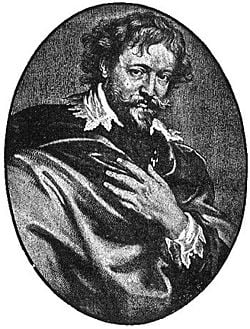 | |
| Birth name | Peter Paul Rubens |
| Born | June 28, 1577 Siegen, Westphalia |
| Died | May 30, 1640 Antwerp, Flanders |
| Nationality | Flemish |
| Field | Painting |
| Movement | Baroque |
Peter Paul Rubens (June 28, 1577 – May 30, 1640) was a prolific seventeenth-century Flemishpainter who is often said to be the greatest of the Northern Baroque artists. This exuberant style emphasized movement, color, sensuality and emotional drama. He is well-known for his Counter-Reformation altarpieces, portraits, landscapes, and history paintings of mythological and allegorical subjects. In addition to running a large studio in Antwerp that produced paintings popular with nobility and art collectors throughout Europe, Rubens was a classically-educated humanist scholar, art collector, and diplomat who was knighted by both Philip IV, king of Spain, and Charles I, king of England.
Biography
Early life
Rubens was born in Siegen, Westphalia, to Jan Rubens and Maria Pypelincks. His father, a Calvinist, and mother fled Antwerp for Cologne in 1568, after increased religious turmoil and persecution of Protestants during the rule of the Spanish Netherlands by the Duke of Alba. Jan Rubens became the legal advisor to Anna of Saxony, the second wife of William I of Orange, and settled at her court in Siegen in 1570. He was drawn into an illicit relationship with the emotionally unbalanced Anna and suffered imprisonment for the affair. After his release Peter Paul Rubens was born in 1577. The family returned to Cologne the next year. In 1589, two years after his father's death, Rubens moved with his mother to Antwerp, where he was raised Catholic. He remained a devout Catholic throughout his adult life and his faith was to inform much of his work. Religion figured prominently in much of his work and Rubens was to be a leading artistic champion of the Catholic Counter-Reformation.[1]
In Antwerp Rubens received a humanist education, studying Latin and classical literature. By fourteen he began his artistic apprenticeship with the little-known Tobias Verhaeght. Subsequently, he studied under two of the city's leading painters of the time, the late mannerists Adam van Noort and Otto van Veen.[2] Much of his earliest training involved copying earlier artists' works, such as woodcuts by Hans Holbein the Younger and Marcantonio Raimondi's engravings after Raphael. Rubens completed his education in 1598, at which time he entered the Guild of St. Luke as an independent master.[3]
Italy (1600–1608)
In 1600, Rubens fulfilled the then popular dream of young artists of travelling to Italy. He stopped first in Venice, where he viewed first-hand paintings by Titian, Veronese, and Tintoretto, before settling in Mantua at the court of duke Vincenzo I of Gonzaga. The coloring and compositions of Veronese and Tintoretto had an immediate effect on Rubens's painting, and his later, mature style was profoundly influenced by Titian.[4] With financial support from the duke, Rubens traveled to Rome by way of Florence in 1601. There, he studied classical Greek and Roman art and copied works of the Italian masters. The Hellenistic sculpture Laocoön and his Sons with its dramatic sense of pathos was especially influential on him, as was the art of Michelangelo, Raphael and Leonardo da Vinci.[5] He was also influenced by the recent, highly naturalistic paintings by Caravaggio, though it is doubtful that the two very different artists ever met. Rubens refinement would have little in commen with the wild, troubled genius of the Italian master. He did however admire his work enough to copy and be influenced by it. During this first stay in Rome, Rubens completed his first altarpiece commission, St. Helena with the True Cross for the Roman church, Santa Croce in Gerusalemme.
Rubens, a gentleman by nature, patient, charming yet also unyielding when necessary was often trusted by the nobility as a diplomat. This was unusual for a man who in his words, "lived by the work of my own hands." [6] He was sent to Spain on a diplomatic mission in 1603, delivering gifts from the Gonzagas to the court of Philip III. While there, he viewed the extensive collections of Raphael and Titian that had been collected by Philip II.[7] He also painted an equestrian portrait of the Duke of Lerma during his stay (Prado, Madrid) that demonstrates the influence of works like Titian's Charles V at Mühlberg (1548; Prado, Madrid). This journey marks the first of many during his career that would combine art and diplomacy.
He returned to Italy in 1604, where he remained for the next four years—first in Mantua, and then in Genoa and Rome. During this time he often found himself frustrated, being used as a mere copyist or to paint portraits of pretty courtiers for the worldly, womanizing Gonzaga. In Genoa, Rubens painted numerous remarkable portraits, such as the the Marchesa Brigida Spinola-Doria (National Gallery of Art, Washington, D.C.), in a style that would influence later paintings by Anthony van Dyck, Joshua Reynolds, and Thomas Gainsborough.[8] He also began a book illustrating the palaces in the city. From 1606 to 1608, he was largely in Rome. During this period Rubens received his most important commission to date for the high altar of the city's most fashionable new church, Santa Maria in Vallicella (or, Chiesa Nuova). The subject was to be St. Gregory the Great and important local saints adoring an icon of the Virgin and Child. The first version, a single canvas (Musée des Beaux-Arts, Grenoble), was immediately replaced by a second version on three slate panels that permits the actual miraculous holy image of the "Santa Maria in Vallicella" to be revealed on important feast days by a removable copper cover, also painted by the artist.[9]
The impact of Italy on Rubens was great. Besides the artistic influences, he continued to write many of his letters and correspondences in Italian for the rest of his life, signed his name as "Pietro Paolo Rubens", and spoke longingly of returning to the peninsula—a hope that never materialized.[10]
Antwerp (1609–1621)
Upon hearing that his mother was seriously ill in 1608, Rubens planned his departure from Italy for Antwerp. Unfortunately, she died before he made it home. His return coincided with a period of renewed prosperity in the city with the signing of Treaty of Antwerp in April 1609, which initiated the Twelve Years' Truce. In September of that year Rubens was appointed court painter by Albert and Isabella, the governors of the Low Countries. He received special permission to base his studio in Antwerp, instead of at their court in Brussels, and to also work for other clients. He remained close to the Archduchess Isabella until her death in 1633, and was called upon not only as a painter but also as an ambassador and diplomat. Although Rubens had planned a return to Italy other circumstances intervened to bind him to the Flemish city. Perhaps the greatest of these was his marriage to Isabella Brant, the eighteen year old daughter of a leading Antwerp citizen and humanist Jan Brant.October 3, 1609. The marriage is commemorated in one of Ruben's most charming portraits of himself and Isabella as newlyweds, flush with the confident joy of youth and exquisitely dressed in the best of 17th century elegance. Their happy union was to last until Isabella's untimely death seventeen years later.
In 1610, he moved into a new house and studio that he designed. Now the Rubenshuis museum, the Italian-influenced villa in the center of Antwerp contained his workshop, where he and his apprentices made most of the paintings, and his personal art collection and library, both among the most extensive in Antwerp. During this time he built up a studio with numerous students and assistants. His most famous pupil was the young Anthony van Dyck, who soon became the leading Flemish portraitist and collaborated frequently with Rubens. He also frequently collaborated with the many specialists active in the city, including the animal painter Frans Snyders, who contributed the eagle to Prometheus Bound (illustrated left), and his good friend Jan Brueghel the Elder who actually did many of the landscape backgrounds of Ruben's paintings.
Altarpieces such as The Raising of the Cross (1610) and The Descent from the Cross (1611–1614) for the Cathedral of Our Lady were particularly important in establishing Rubens as Flanders' leading painter shortly after his return. The Raising of the Cross, for example, demonstrates the artist's synthesis of Tintoretto's Crucifixion for the Scuola di San Rocco in Venice, Michelangelo's dynamic figures, and Rubens's own personal style. This painting is a prime example of High Baroque religious art. The sinewy upward s-curve of the twisting, muscular figures as well as the saturated colors and strong lighting brilliantly reflect this style.[11]
Rubens, best known as a painter, also did woodcuts and produced cartoons (large drawings) to be woven by others into huge tapestries which were hung in various courts throughout Europe. His drawings, though masterful works of art in themselves, were not signed by the artist. They were scattered over many countries after his lifetime. These works, usually done in chalk, show the master's great skill and speed in working out images of the human figure which could then be translated into larger paintings. They provide valuable insight into his thought processes and working methods.
The Marie de' Medici Cycle and diplomatic missions (1621–1630)
In 1621, the queen-mother of France, Marie de' Medici, commissioned Rubens to paint two large allegorical cycles celebrating her life and the life of her late husband, Henry IV, for the Luxembourg Palace in Paris. The life of Marie de' Medici (now in the Louvre) was installed in 1625, and although he began work on the second series it was never completed.[12] Marie was exiled from France in 1630 by her son, Louis XIII, and died in 1642 in the same house in Cologne where Rubens had lived as a child.[13]
After the end of the Twelve Years' Truce in 1621, the Spanish Habsburg rulers entrusted Rubens with a number of diplomatic missions.[14] Between 1627 and 1630, Rubens's diplomatic career was particularly active, and he moved between the courts of Spain and England in an attempt to bring peace between the Spanish Netherlands and the United Provinces. He also made several trips to the Northern Netherlands as both an artist and a diplomat. At the courts he sometimes encountered the attitude that courtiers should not use their hands in any art or trade, but he was also received as a gentleman by many. It was during this period that Rubens was twice knighted, first by Philip IV of Spain in 1624, and then by Charles I of England in 1630. He was also awarded an honorary Master of Arts degree from Cambridge University in 1629.[15]
Rubens was in Madrid for eight months in 1628–1629. In addition to diplomatic negotiations, he executed several important works for Philip IV and private patrons. He also began a renewed study of Titian's paintings, copying numerous works including the Madrid Fall of Man (1628–29; illustrated right).[16] During this stay, he befriended the court painter Diego Velázquez. The two planned to travel to Italy together the following year. Rubens, however, returned to Antwerp and Velázquez made the journey without him.[17]
His stay in Antwerp was brief, and he soon traveled on to London. Rubens stayed there until April, 1630. An important work from this period is the Allegory of Peace and War (1629; National Gallery, London).[1]. It illustrates the artist's strong concern for peace, and was given to Charles I as a gift.
While Rubens's international reputation with collectors and nobility abroad continued to grow during this decade, he and his workshop also continued to paint monumental paintings for local patrons in Antwerp. The Assumption of the Virgin Mary (1625-6) for the Cathedral of Antwerp is one prominent example.
Last decade (1630–1640)
Rubens's last decade was spent in and around Antwerp. Major works for foreign patrons still occupied him, such as the ceiling paintings for the Banqueting House at Inigo Jones's Palace of Whitehall, but he also explored more personal artistic directions.
In 1630, four years after the death of his first wife, the 53-year-old painter married 16-year-old Hélène Fourment. Hélène inspired the voluptuous figures in many of his paintings from the 1630s, including The Feast of Venus (Kunsthistorisches Museum, Vienna), The Three Graces (Prado, Madrid) and The Judgment of Paris (Prado, Madrid). In the latter painting, which was made for the Spanish court, the artist's young wife was recognized by viewers in the figure of Venus. In an intimate portrait of her, Hélène Fourment in a Fur Wrap, also known as Het Pelsken (illustrated left), Rubens's wife is even partially modeled after classical sculptures of the Venus Pudica, such as the Medici Venus.
In 1635, Rubens bought an estate outside of Antwerp, the Château de Steen (Het Steen), where he spent much of his time. Landscapes, such as his Château de Steen with Hunter (National Gallery, London; illustrated right) and Farmers Returning from the Fields (Pitti Gallery, Florence), reflect the more personal nature of many of his later works. He also drew upon the Netherlandish traditions of Pieter Bruegel the Elder for inspiration in later works like Flemish Kermis (c. 1630; Louvre, Paris).
On May 30, 1640, Rubens died at age 63 of gout, and was interred in Saint Jacob's church, Antwerp. Between his two marriages the artist had eight children, three with Isabella and five with Hélène; his youngest child was born eight months after his death.
Art
Rubens was a prolific artist. His commissioned works were mostly religious subjects, "history" paintings, which included mythological subjects, and hunt scenes. He painted portraits, especially of friends, and self-portraits, and in later life painted several landscapes. Rubens designed tapestries and prints, as well as his own house. He also oversaw the ephemeral decorations of the Joyous Entry into Antwerp by the Cardinal-Infante Ferdinand in 1635.
His drawings are mostly extremely forceful but not detailed; he also made great use of oil sketches as preparatory studies. He was one of the the last major artists to make consistent use of wooden panels as a support medium, even for very large works, but he used canvas as well, especially when the work needed to be sent a long distance. For altarpieces he sometimes painted on slate to reduce reflection problems.
Workshop
Paintings can be divided into three categories: those painted by Rubens himself, those which he painted in part (mainly hands and faces), and those he only supervised. He had, as was usual at the time, a large workshop with many apprentices and students, some of whom, such as Anthony Van Dyck, became famous in their own right. He also often sub-contracted elements such as animals or still-life in large compositions to specialists such as Frans Snyders, or other artists such as Jacob Jordaens.
Value of his works
At a Sotheby's auction on July 10, 2002, Rubens' newly discovered painting Massacre of the Innocents (illustrated right) sold for £49.5million ($76.2 million) to Lord Thomson. It is a current record for an Old Master painting.
Recently in 2006, however, another lost masterpiece by Rubens, The Calydonian Boar Hunt, dating to 1611 or 1612, was sold to the Getty Collection in Paris for an unknown amount. It had been mistakenly attributed to a follower of Rubens for centuries until art experts authenticated it.[2]
Rubens in popular culture
As many of his paintings feature full-figured, voluptuous women, the word "Rubenesque" (meaning plump or fleshy, yet not "fat," and used exclusively to describe women) is derived from his last name.[3]
Notes
- ↑ Belkin (1998): 11–18.
- ↑ Held (1983): 14-35.
- ↑ Belkin (1998): 22–38.
- ↑ Belkin (1998): 42; 57.
- ↑ Belkin (1998): 52–57
- ↑ The World of Rubens, C.V. Wedgewood, Time Incorporated, New York (1967): p.80
- ↑ Belkin (1998): 71–73
- ↑ Belkin (1998): 75.
- ↑ Jaffé (1977): 85–99; Belting (1994): 484–90, 554–56.
- ↑ Belkin (1998): 95.
- ↑ Martin (1977): 109.
- ↑ Belkin (1998): 175; 192; Held (1975): 218–233, esp. pp. 222–225.
- ↑ Belkin (1998): 173-175.
- ↑ Belkin (1998): 199–228.
- ↑ Belkin (1998): 339–340
- ↑ Belkin (1998): 210–218.
- ↑ Belkin (1998): 217–218.
Bibliography
- Belkin, Kristin Lohse (1998). Rubens. Phaidon Press. ISBN 0-7148-3412-2.
- Belting, Hans (1994). Likeness and Presence: A History of the Image before the Era of Art. University of Chicago Press. ISBN 0226042154.
- Held, Julius S. (1975) "On the Date and Function of Some Allegorical Sketches by Rubens." In: Journal of the Warburg and Courtauld Institutes. Vol. 38: 218–233.
- Held, Julius S. (1983) "Thoughts on Rubens' Beginnings." In: Ringling Museum of Art Journal: 14–35. ISBN 0-916758-12-5.
- Jaffé, Michael (1977). Rubens and Italy. Cornell University Press. ISBN 0801410649.
- Martin, John Rupert (1977). Baroque. HarperCollins. ISBN 0064300773.
- Mayor, A. Hyatt (1971). Prints and People. Metropolitan Museum of Art/Princeton. ISBN 0691003262.
- Pauw-De Veen, Lydia de. "Rubens and the graphic arts." In: Connoisseur CXCV/786 (Aug 1977): 243–251.
Further reading
- Alpers, Svetlana. The Making of Rubens. New Haven 1995.
- Heinen, Ulrich, "Rubens zwischen Predigt und Kunst." Weimar 1996.
- Büttner, Nils, Herr P. P. Rubens. Göttingen 2006.
- Corpus Rubenianum Ludwig Burchard. An Illustrated Catalogue Raisonne of the Work of Peter Paul Rubens Based on the Material Assembled by the Late Dr. Ludwig Burchard in Twenty-Seven Parts, Edited by the Nationaal Centrum Voor de Plastische Kunsten Van de XVI en de XVII EEUW.
- Lilar, Suzanne, Le Couple (1963), Paris, Grasset; Reedited 1970, Bernard Grasset Coll. Diamant, 1972, Livre de Poche; 1982, Brussels, Les Éperonniers, ISBN 2-8713-2193-0; Translated as Aspects of Love in Western Society in 1965, by and with a foreword by Jonathan Griffin, New York, McGraw-Hill, LC 65-19851.
- Vlieghe, Hans, Flemish Art and Architecture 1585-1700, Yale University Press, Pelican History of Art, New Haven and London, 1998.
See also
- Paintings by Rubens
- List of Flemish painters
- Western painting
- History of Painting
External links
- National Gallery: Rubens
- The Guardian: Rubens
- At the exhibition Drawings by Peter Paul Rubens in the Metropolitan Museum of Art (MET) of New-York 115 drawings of Pieter-Paul Rubens were on display in April 2005. http://www.metmuseum.org/
- The Allegory of Peace and War
- The Virgin and Child with St Elizabeth and the Child Baptist 1630-35
- Rubenshuis in Antwerp, Belgium is the former house of Rubens, now converted into a museum.
Credits
New World Encyclopedia writers and editors rewrote and completed the Wikipedia article in accordance with New World Encyclopedia standards. This article abides by terms of the Creative Commons CC-by-sa 3.0 License (CC-by-sa), which may be used and disseminated with proper attribution. Credit is due under the terms of this license that can reference both the New World Encyclopedia contributors and the selfless volunteer contributors of the Wikimedia Foundation. To cite this article click here for a list of acceptable citing formats.The history of earlier contributions by wikipedians is accessible to researchers here:
The history of this article since it was imported to New World Encyclopedia:
Note: Some restrictions may apply to use of individual images which are separately licensed.
